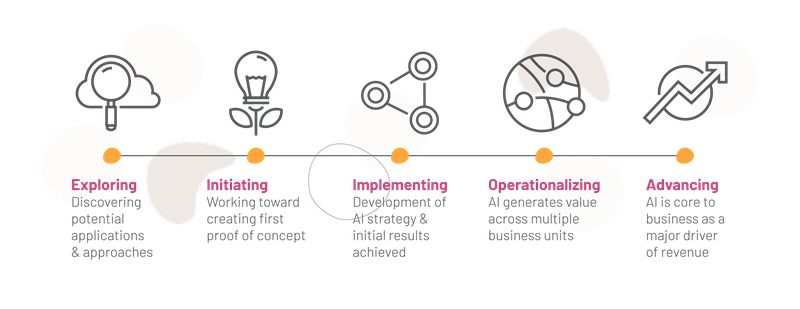News
I’m a complete beginner – where do I start with AI?

Now that you have a basic understanding of what AI is, let’s take a look at how you can get on the path to adopting it in your business!
Here at Amii, we use the AI Adoption Spectrum to gauge a company’s AI capabilities and map out how they can move forward – and it all begins with “Exploring: Discovering potential applications and approaches”.

Here are three things you can do to get to that first step:
Learn the language
Start with developing a shared, common language around AI and machine learning, as well as basic understanding of the concepts. Laying this groundwork is critical for teams who want to have meaningful conversations around the projects and ideas that will accelerate the outcomes that matter most to your business.
There are lots of classes and resources available online for beginners, including our own ML Foundations 1 & ML Foundations 2 classes. The important part is ensuring that everyone on your team is taking in the same information, so that you are growing your vocabulary and understanding together.
Know your data
AI and machine learning algorithms are only as good as the data they’re built and tested on. Taking stock of the data you’re currently collecting, how much you have, the format it’s in, and the processes around collecting, processing and storing it will be important – this will inform what types of systems you will be able to build.
Mapping this out will also help you see any gaps in your current processes. Generally, AI systems require foundational pieces to reach their full potential, such as capabilities for data storage, management and analytics.
Pinpoint the opportunities
Once your team has built a shared vocabulary around AI and machine learning and understanding of the company’s data, you’re ready to begin investigating possible opportunities!
Get together with your team to brainstorm opportunities. Take inspiration from what your competitors or others in your industry are doing. Once you have a list of ideas, determine how much effort each would take, as well as the risk level.
The best beginner projects are those that require low effort and hold low risk (we call these quick wins). Beginning with these projects will allow your team to build experience and confidence. While exploring quick wins, consider the long-term, strategic direction you want to take with AI. It has been shown that companies with a long-term view see a better ROI.
We’ve seen great value in guided brainstorming through our AI Planning and Initiating (AIPI) sessions, where Amii experts help companies to examine their current data and discover and prioritize possible AI and machine learning opportunities. Finally, top ideas are refined further using our AI lean canvas.
Taking the plunge
Once you’ve chosen the problem you want to work with, it’s time to decide who should develop your AI solution – that is, whether you’d like to build the solution in-house, buy an existing solution, or partner with another organization to build a custom solution. There are pros and cons to each option, which we’ll explore in next month’s article!
Learn more about how you can use AI in your business
- Your burning AI questions are answered every month in AI & Your Business News – get it in your inbox.
- Contact us below! We're here if you want to float an idea, ask questions or chat. Fill out the form below and someone from our team will get back to you soon:
Latest News Articles

Nov 7th 2024
News
AI for Good: Harnessing AI to Keep Online Spaces Safe for Indigenous Communities
Amii partners with pipikwan pêhtâkwan and its startup company wâsikan kisewâtisiwin, to harness AI in efforts to challenge misinformation about Indigenous People and include Indigenous People in the development of AI. The project is supported by the PrairiesCan commitment to accelerate AI adoption among SMEs in the Prairie region.

Nov 7th 2024
News
Russ Greiner named recipient of the 2024 Brockhouse Canada Prize
Amii Fellow and Canada CIFAR AI Chair Russ Greiner and University of Alberta researcher and collaborator David Wishart were awarded the Brockhouse Canada Prize for Interdisciplinary Research in Science and Engineering from the National Sciences and Engineering Research Council of Canada (NSERC).

Nov 6th 2024
News
Amii founding member Jonathan Schaeffer retiring from university after 40 years of game-changing AI
Amii founding member Jonathan Schaeffer has spent 40 years making huge impacts in game theory and AI. Now he’s retiring from academia and sharing some of the insights he’s gained over his impressive career.
